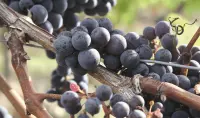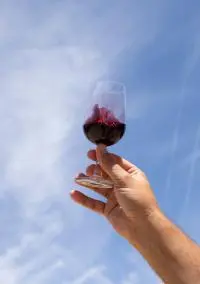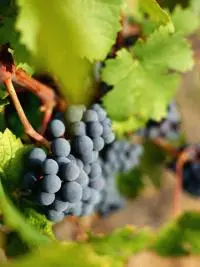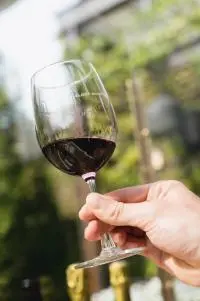The reds
The reds

How to choose a Loire red wine?
The red wines of the Loire promise a journey between freshness and character. With their varied terroirs, they offer a palette that ranges from light, fruity reds to denser, more structured wines suited to prolonged cellaring.
Each bottle has its secrets, and above all, its perfect occasion.
Among the must-tries is Saint-Nicolas-de-Bourgueil. Ideal for those who like fresh, supple reds, it's appreciated for its lightness and fruity aromas of cherry and raspberry.
Envy of a fuller-bodied red? The Bourgueil, with its intense red and black fruit flavors, embodies the generosity of Loire red wines.
And the Chinon? Both elegant and well-balanced, it seduces with notes of blackcurrant and redcurrant. Young, it plays the freshness card. With age, it reveals deeper aromas of spices and stewed black fruit. Our advice: decant a young Chinon to soften its tannins, and an old vintage to enhance its complexity.
As for Saumur-Champigny, it embodies elegance. Beneath its luminous garnet color lie aromas of violets, red and black fruits. Young, it's all fruit; with time, it'll gain depth!
The more discreet nuggets are not to be outdone, and have some lovely surprises in store: the Coteaux d'Ancenis offer fruity, light wines, while the Anjou-Villages and Anjou-Brissac are distinguished by their deep ruby color, with flowery aromas evolving towards black fruits and undergrowth.
The Coteaux du Loir and the Coteaux du Vendômois deserve your full attention. The former will surprise you with its delicacy, while the latter will awaken your taste buds with its spicy notes.
The journey continues inTouraine, where the wines vie for originality, with a Touraine-Chenonceaux that combines stewed black fruit and minty freshness, or with a Touraine-Mesland, with aromas of raspberry and blackcurrant.
Finally, head for Saumur, with a Saumur Rouge that shines with its suppleness, while the Saumur Puy-Notre-Dame offers a more structured and intense experience.

How do you pair Loire red wines with food?
Like white wines, Loire red wines can sublimate a multitude of dishes. From light, fruity cuvées to powerful, tannic reds, they lend themselves equally well to simple meals and festive occasions.
What dish with a powerful, tannic red wine?
Powerful, tannic red wines, such as Chinon or Bourgueil, offer a lovely structure. They are the perfect accompaniment to red meats, whether grilled or stewed. With a lightly aged Chinon (3-4 years), you'll get a perfect match between its elegant tannins and the meat's melt-in-the-mouth texture.
For dishes like roast turkey or capon, turn to a Bourgueil that blends ripe fruit and light woody notes, for a harmonious, gourmet result.
Hungry for a comforting dish that will warm up long winter evenings? A Saumur-Champigny will bring roundness and freshness to gratins, raclettes and fondues.
What dish with a light, fruity red wine?
Light, fruity red wines from the Loire, pair ideally with delicate dishes. The Coteaux du Vendômois, with its notes of red fruits enhanced by red spices, creates a harmonious pairing with poultry and white meats, enhancing their flavors gently. Tasted with vegetarian dishes, the aromatic notes of Saint-Nicolas-de-Bourgueil will flatter the palate with lightness and freshness.
To enhance the taste of blue-veined or hard cheeses, there's nothing like the round, silky wines of Touraine (Touraine Amboise, Touraine Chenonceaux, Touraine-Mesland). They bring a lovely freshness that contrasts with the generosity of the melted cheese. These light reds also go well with charcuterie boards to share with friends: buddies like pigs, we guarantee!

How to enjoy Loire red wine
The red wines of the Loire are a true delight for the senses. To savor their full richness, serving temperature is essential. Too hot, it accentuates the tannins and hides the aromas; too cold, it smothers the flavors.
For light, fruity wines, a little cooling (12-14°C) will bring out the freshness of the fruit. For fuller-bodied reds, serve at 15-17°C to release the full complexity of flavors.
The glass also plays an important role. Choose a red wine glass with a slightly narrow opening: it will concentrate the aromas so you can better appreciate them. An elegant glass, neither too large nor too massive, will make all the difference.
Before savoring, take a moment to observe the wine's color. From crimson to ruby, each color says a lot about the grape variety and age of the wine. On the nose, let the aromas surprise you: red fruits such as cherry or raspberry for young wines, black fruits and spices for older vintages. On the palate, the balance between acidity, tannins and structure will reveal the wine's finesse.
.
How to recognize a ready-to-drink red wine?
A ready-to-drink red wine from the Loire region features fresh aromas of red fruit, such as raspberry or strawberry, that reveal themselves with the first sip. A ruby or purplish-red color, combined with supple tannins and a lovely lightness, results in a wine that's easy to enjoy, all freshness.
As for the vins de garde, they present a more evolved color, melted tannins and complex aromas of undergrowth or spices. After a few years in the cellar, they reveal their full richness.
No matter how old they are, balance and freshness remain the watchwords for Loire reds ready to be savored!
What is the shelf life of red wine?
Most Loire red wines taste perfectly between two and five years. TheChinon and Bourgueil, in particular, gain in complexity after 8 to 10 years, as do some Saumur which continue to improve. For those who prefer younger wines, light, fruity reds are ideal in the first two years after bottling, offering freshness and vivacity.
What role does maturation play in red wine?
Maturation is the secret behind the evolution of Loire red wines. It refines their structure, exalts their aromas and gives them that stability that makes all the difference. After alcoholic fermentation, malolactic fermentation comes into play to soften the wine, making it rounder and more stable. As for ageing, it's mainly done in vats, but sometimes a passage in oak casks or foudre for the more daring, to give body and complexity.
What are the different grape varieties for red wine?
The Cabernet Franc, the emblematic grape variety of Chinon, Bourgueil, Saint-Nicolas-de-Bourgueil, Saumur and Saumur-Champigny, stands out for its ability to produce fruity, structured wines. The Cabernet Sauvignon, rarer in the Loire, is found mainly in the Anjou-Villages and Anjou-Brissac, where it adds power and color.
The Côt (or Malbec), a typical Touraine grape variety, is distinguished by robust, deep wines, especially in the Cher valley. Often combined with Cabernet Franc or Gamay, it offers balanced, aromatic blends.
Pineau d'Aunis brings its unique touch to appellations such as Coteaux-du-Loir. This grape variety, with its spicy, peppery soul, produces wines with strawberry and cherry aromas, fresh and vibrant, inviting you to discover another aspect of the Loire terroir.
Gamay, meanwhile, is a flagship grape variety in Touraine and the Nantais vineyards. It produces young red wines, often light and gourmand, but can also be blended (with Cabernet Franc or Côt) to offer more complex results.
We can also mention complementary grape varieties such as Pinot Meunier,the Négrette and the Merlot, which contribute to the diversity and richness of Loire reds in certain appellations.
